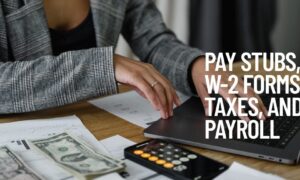Self-employed individuals are responsible for paying a similar government income tax as everyone else. The variation that matters is that they don’t have an employer to keep money from their paycheck and send it to the IRS or share the trouble of paying Social Security and Medicare taxes. They need to monitor their pay, estimate how much tax they should owe, and that is where a self-employed quarterly tax calculator comes to their rescue for estimating taxes throughout the year.
What is exactly a Self-Employment Tax?
The whole idea is to save some money legitimately and lower the medicare burdens essentially for people who work independently. It is the same as the Social Security and Medicare taxes withheld from the pay of most workers. You can figure out the self-employed Tax (SE tax) yourself by utilizing Schedule SE (Form 1040 or 1040-SR). Additionally, you can deduct the employer equivalent portion of your Self-employed quarterly tax calculator to your changed gross pay. Workers can’t deduct Social Security and Medicare charges.
In addition to personal income taxes, everyone should pay Social Security and Medicare charges. You have to make these tax payments yourself if you are working independently since you don’t have a worker to send them in for you. Workers have to pay 7.65 percent of their pay in Social Security and Medicare charges, with their managers making an extra payment of 7.65 percent. The Social Security part of the tax is paid on the first $142,800 of business pay in the year.
Unfortunately, when you are working independently, you have to pay the two segments of these taxes for an aggregate amount of 15.3 percent. However, you can get to claim an allowance for a part of this when you document your tax form. You can also work out and find these employment charges on a Schedule SE connection to your tax return form.
Calculating self-employment income
Whenever you work for another person, you will get a W-2 form from your manager toward the year-end telling you to know exactly how much amount you made. When you are self-employed, you need to sort it out by yourself. That implies you should keep exact records of how much you acquire for your work and the amount you spend to work your business.
This record-keeping is exclusively your responsibility, and then you are the chief. Utilize Schedule C to report your business income and costs at tax time. Deduct the costs from the income to get your net profit from independent work. Your net profit is then built-in for your income tax filing form and taxed similarly to your other payments. If you take care of business as a self-employed entity, you can hope to get 1099 structures from your clients, announcing the amount they paid you during the year.
Estimating your income tax
When you are a worker, your boss will keep the money for government taxes out of your paychecks and send the cash to the IRS so that before the year-end, your expected tax bill should be paid. However, if you are working independently, this is another activity you need to deal with yourself.
Rather than paying it every week, you should make four assessed tax payments during the year. Since you are doing this while the tax year is in the works, you can give your best estimate based on the pay you acquire in the current tax rates.
Other ways to estimate tax payments
If you have a daily job in addition to your freelancing business, you may be able to increase your federal tax withholding at that job to cover the self-employed quarterly tax calculator on your independent employed income. However, if you still owe at least $1,000 even after raising your withholding, you must make a few estimated tax payments. You w don’t want to pay estimated taxes if you can execute that.
At year-end, your estimated payments (with employer withholding) must equal at least 90 percent of your tax liability for the current year or 100 percent of your tax liability from the previous year. If it doesn’t, you may be focused on an estimated tax penalty.
Self-employment Health Insurance Tax Deduction
Under Section 2042 of the Small Business Jobs Act, a deduction for income tax purposes is permitted to independently employed people at medical insurance expense. This allowance is considered an account in calculating a net income from independent work. You can also consider the Form 1040 or 1040-SR and Schedule SE guidelines for computing and claiming the deduction.
Who Must Pay Self-Employment Tax?
You should duly pay the tax expenses and document Schedule SE (Form 1040 or 1040-SR) if both the following conditions apply.
- Your net profit from independent work (excluding church employee pay) was $400 or more.
- You had church employees pay $108.28 or more.
Generally, your net profits from independent work are dependent upon self-employment tax. Assuming you are independently employed as a sole owner, you can most partly use Schedule C to figure out the net profit from independent work.
If you have profit subject to self-employment tax, use Schedule SE to calculate your net income from independent work. Before you figure out your net profit, you generally need to calculate your total income subject to independent work tax.
Special guidelines apply to laborers who act in-home administrations for older or disabled people (caregivers). Guardians are regular employees of the people for whom they provide various services since they work in the homes of the older or physically challenged people. These people reserve the privilege of telling the caregivers what should be finished.
Instructions to Pay Taxes for freelancers:
You should have a Social Security number (SSN) or an individual taxpayer recognizable proof number (ITIN) to settle self-employment.
- Acquiring a Social Security Number: If you never had an SSN, apply for one is utilizing Form SS-5, Application for a Social Security Card. Download the application form from the social security website. You can get this application form at any Social Security office or by calling the office number.
- Acquiring an Individual Taxpayer Identification Number: The IRS will give you an ITIN if you are a non-resident or resident outsider and you don’t have and are not qualified to get an SSN. To submit an application for an ITIN, document the Form W-7, Application for IRS Individual Taxpayer Identification Number.
- Estimating Tax deductions: As a self-employed individual, you might need to record Estimated Taxes quarterly. You can utilize these estimated tax payments to pay your independent employee tax, as well as know the deductions you are eligible for.
Bottom line
You must pay a tax return if you are working as a freelancer. For paying and deducting a tax, you have to estimate the sales and profit of your business carefully.



































